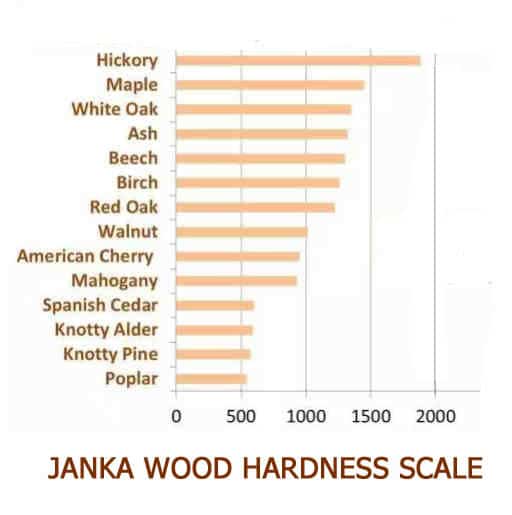There are many types of wood out there, but not all of them have the same performance rates. Luckily, we can do some tests and make adequate comparisons between them. One area in which types of wood differ from each other is the level of hardness. To measure which wood is hardest and which softest, experts use the Janka Hardness Scale. This scale was invented in 1906 by Gabriel Janka (thus the name Janka scale) who was an expert on wood. In the US, it was officially accepted and standardized in 1927 by the ASTM (American society for testing and material).
HOW DO YOU MEASURE HARDNESS?
To measure a wood’s hardness, you must do it according to Janka’s testing methods. The test is very simple. Experts just take a piece of wood of 2x2x6 inches and place a steel ball of 0.444 inches on top. Then they measure how much force is needed for the wood to go halfway through the piece of wood. This is expressed in pounds per square inch, also known as PSI.
THE FACTORS WE SHOULD HAVE IN MIND
When testing a wood’s hardness according to the Janka Tests, we must take in mind the grains. For instance, flat grains are treated as normal, regular and these results are shown on the scale whereas vertical ones aren’t. A piece of wood can be tested on its sides and ends which show a different rating which isn’t displayed on the acceptable scale.
IS THE JANKA SCALE COMPLICATED?
Putting wood grains on the side, the Janka Hardness Scale isn’t that complicated. The system behind it is simple, the higher rating a wood has, the harder it is. The scale starts from 0 (softest) and ends at 4000 (hardest). These numbers are only achievable in theory since there isn’t a type of wood in real life with a rating of 0.
WHICH WOOD HAS A GOOD RATING?
We should mention how the Janka Scale shouldn’t be taken for granted. The performance of a wood will mainly depend on how you treat it. If it isn’t treated properly, a wooden plank with a high hardness scale won’t perform the way it is expected to.
Apart from maintenance, climate and foot traffic are definitely factors which influence the durability of wooden flooring. We will mention some of the ratings for specific types of wood below.
WHICH WOOD HAS A BAD RATING?
Currently, the wood with the lowest ratings on the Janka Scale is balsa rated at 100. Because of its softness, this wood is mainly used in arts & crafts and would never be used for furniture and flooring. For a piece of wood to be used in floors, it should have a rating of around a 1000.
IMPORTANT FACTS ABOUT OAK
In the realm of flooring, both red and white oak are popular amongst manufacturers and buyers. Their popularity isn’t connected to their rating on the Janka Scale, but with their availability. Because there is an abundance of oak, it is also one of the cheapest options on the market. For those that are curious about its hardness ratings though, red oak rates at 1260 white white rates at 1360.
IS BAMBOO A GOOD OPTION?
Bamboo is one of the best types of wood when it comes to hardness. Along with Eucalyptus, it has one of the highest performances, reaching a rating from 3800 to 5000 on the Janka Hardness Scale. These variations are dependent on the quality of the manufacturing process. Have in mind that the hardness of the wood determines how much it is prone to wear & tear over the years.
CAN YOU MEASURE ENGINEERED WOOD?
Unfortunately, engineered hardwood cannot be rated according to the Janka tests. This is because each hardwood flooring is unique on its own. The man-made factor cannot be separated from the wood and this makes it harder for experts to determine certain numbers that apply to every engineered hardwood piece out there.
Additionally, this type of wood consists of softer layers, so it simply wouldn’t be fair to conduct Janka tests when we already know about the presence of a softer compound within it. Apart from not being fair, it wouldn’t be scientifically accurate.
THE IMPORTANCE OF THE JANKA HARDNESS SCALE
Before we start to discuss the importance of the Janka Scale, we must highlight how these ratings don’t speak about the wood’s strength, they only signify its ability to withstand wear and tear over the years (this especially applies in the case of flooring). Furthermore, as mentioned before, a wood’s durability will mainly depend on maintenance.
For example, if one homeowner chooses a softer wood (with a lower rating on the Janka Scale), but treats it with the needed care and respect, it will last much longer than a harder wood which hasn’t gotten the needed maintenance over the years. This means that you shouldn’t focus so much on these numbers, but make the decisions according to price and quality of manufacturing.
THE DIFFERENCE IN PRICING
Of course, if you frequently move furniture around the house, have kids and pets, or have the habit of yearly renovations, you should definitely choose a harder wood. Luckily, the pricing doesn’t depend on how hard a wood is. A wood that has the highest scores on the Janka Scale isn’t necessarily the most expensive option.
The pricing of wooden materials is mainly influences by availability, popularity, and ease of manufacturing. Materials which are in abundance and are easy to work with tend to be much cheaper.
